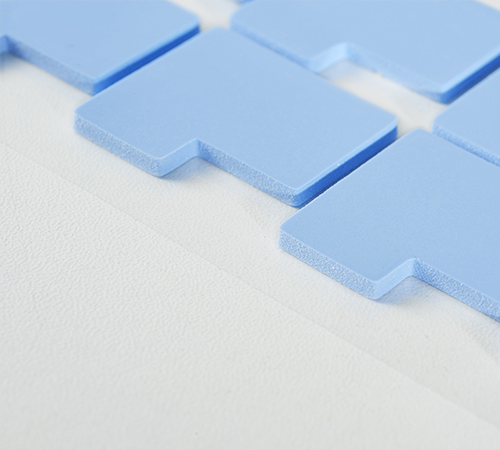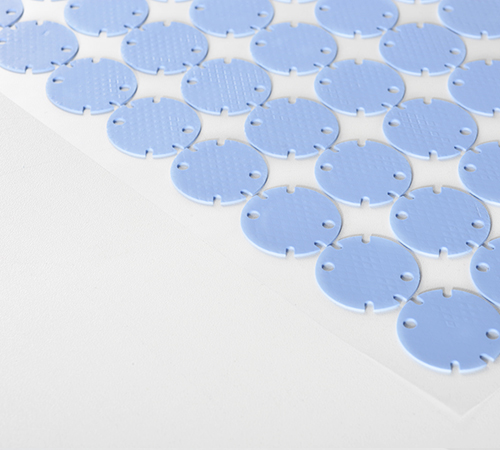
With the rapid development of electronic technology, memory, as one of the core components in computers, has seen its performance enhancement and stability assurance become increasingly crucial. Thermal conductive silicone pads, as an efficient heat transfer material, are garnering growing attention from the industry in their application within memory modules.
Thermal conductive silicone pads exhibit excellent thermal conductivity and good electrical insulation properties, rendering them an ideal heat dissipation solution for memory modules. During memory operation, heat generated by the thermal effect of current and high-speed computations can cause the temperature of memory chips to rise. If this heat is not promptly dissipated, it will have adverse effects on the stability and lifespan of the memory. The thermal conductive silicone pad effectively transfers the heat produced by the memory chip to the heat sink or cooler, thereby significantly reducing the operating temperature of the memory and ensuring its stable operation.

The primary role of thermal conductive silicone pads in memory applications is to improve thermal management of memory modules, ensuring their stable and efficient operation. Here are the specific functions and advantages of thermal conductive silicone pads in memory applications:
1.Thermal Conduction Medium:
Filling Gaps: Memory chips (such as DRAM particles) generate heat during operation, while memory modules are typically installed in memory slots on the motherboard, with minute gaps existing between the module and the slot, as well as between the chip and any accompanying memory heat sink. Due to their flexibility and compressibility, thermal conductive silicone pads can accurately conform to these gaps, effectively filling air gaps and eliminating thermal bottlenecks.
Enhancing Heat Transfer Efficiency: Thermal conductive silicone pads possess a high thermal conductivity coefficient, allowing them to rapidly transfer heat generated by the memory chip to the heat sink or directly to the motherboard's cooling pathways, lowering the chip surface temperature and preventing overheating-induced performance degradation, data errors, or even hardware damage.
2.Electrical Insulation Protection:
Electrical Isolation: Operating under high voltage conditions, thermal conductive silicone pads not only offer good thermal conductivity but also exhibit exceptional insulation properties, enabling them to transfer heat while guarding against short-circuit risks and protecting sensitive electronic components from electrostatic discharge (ESD) or other electrical interference.
3.Mechanical Buffering & Stress Relief:
Adaptive Assembly: Due to potential exposure to vibrations, thermal expansion, and contraction during installation and use, the softness and elasticity of thermal conductive silicone pads help absorb and distribute such stresses, safeguarding memory chips and connection points from physical damage.
Flatness Compensation: Even if minor irregularities exist on the surface of the motherboard or memory cooler, the thermal conductive silicone pad can utilize its deformation capability to achieve uniform contact, ensuring continuous and effective thermal conduction.
4.Simplified Thermal Design & Installation:
Ease of Application: Thermal conductive silicone pads are usually self-adhesive, requiring no additional fixing devices to securely adhere between the memory chip and heat sink, simplifying the installation process of the cooling solution and reducing manufacturing costs and complexity.
Customization Options: Tailored to different types of memory modules and cooling requirements, thermal conductive silicone pads offer a variety of thicknesses, sizes, and shapes, and can even undergo die-cutting processing to precisely match the contour of specific memory components, ensuring optimal thermal contact area.
5.Long-Term Stability & Reliability:
Temperature & Weather Resistance: Thermal conductive silicone pads typically maintain their physical and electrical properties over a wide temperature range and exhibit good weather resistance, resisting aging, hardening, or chemical reactions, ensuring they continuously provide effective cooling support throughout the entire lifecycle of the memory component.
Environmentally Friendly & Harmless: Many thermal conductive silicone pads are made from non-toxic, non-corrosive materials, meeting the environmental and safety requirements of electronic devices.
In summary, thermal conductive silicone pads play a critical role in thermal management within memory applications. By providing efficient thermal conduction, reliable electrical insulation, effective mechanical buffering, and ease of installation, they significantly enhance the overall thermal efficiency and system stability of memory modules.



 CN >
CN >



